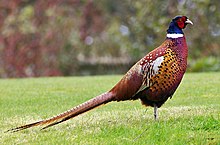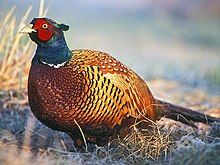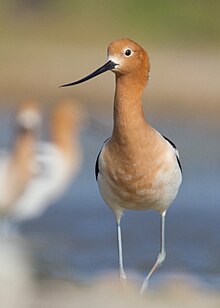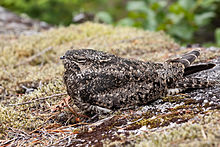“Birds are the most popular group in the animal kingdom. We feed them and tame them and think we know them. And yet they inhabit a world which is really rather mysterious.” David Attenborough


Let’s start with the state bird, the colorful Ring-Necked Pheasant which name is used for the species as a whole in North America and also the collective name for a number of subspecies and their intergrades that have white neck rings.
It is a well-know and of regional importance perhaps the most widespread and ancient one in the whole world. The common pheasant is one of the world’s most hunted birds; it has been introduced for that purpose to many regions, and is also common on game farms where it is commercially bred. Ring-necked pheasants in particular are commonly bred and were introduced to many parts of the world; the game farm stock, though no distinct breeds have been developed yet, can be considered semi-domesticated. It is one of only three U.S. state birds that is not a species native to the United States.


The amazing American Avocet measures has a wingspan of 27 – 30 inches and weighs on average about 12 ounces. The bill is black, pointed, and curved slightly upwards towards the tip. It is long, surpassing twice the length of the avocet’s small, rounded head. Like many waders, the avocet has long, slender legs and slightly webbed feet. The legs are a pastel grey-blue, giving it its colloquial name, blue shanks. The plumage is black and white on the back, with white on the underbelly. During the breeding season, the plumage is brassy orange on the head and neck, continuing somewhat down to the breast. After the breeding season, these bright feathers are swapped out for white and grey ones.

Around the Bird Feeder Puzzle


The sandhill crane is a species of large crane of North America and extreme northeastern Siberia. The common name of this bird refers to habitat like that at the Platte River on the American Plains. This is the most important stopover area for the nominotypical subspecies, the lesser sandhill crane with up to 450,000 of these birds migrating through annually.
The sandhill crane was formerly placed in the genus Grus, but a molecular phylogenetic study published in 2010 found that the genus, as then defined, was polyphyletic. In the resulting rearrangement to create monophyletic genera, four species, including the sandhill crane, were placed in the resurrected genus Antigone that had originally been erected by the German naturalist Ldwig Reichenbach in 1853. The specific epithet canadensis is the modern Latin word for “Canadian”.

Grebes are small to medium-large freshwater diving birds. They have lobed toes and are excellent swimmers and divers. However, they have their feet placed far back on the body, making them quite ungainly on land. Six species have been recorded in South Dakota.
The western grebe is the largest North American grebe. It is black-and-white, with a long, slender, swan-like neck and red eyes. It is easily confused with Clark’s grebe, which shares similar features, body size, behavior and habitat, and hybrids are known. Western grebes nest in colonies on lakes that are mixed with marsh vegetation and open water. Western Grebe nests are made of plant debris and sodden materials, and the nest building begins roughly around late April through June. The construction is done by both sexes and is continued on throughout laying and incubation. This species of waterbirds is widespread in western North America, so there is no specific place of abundance. Its subspecies, Clark’s grebe generally populate more of the southern part of North America. The western grebe has black around the eyes and a straight greenish-yellow bill whereas the Clark’s grebe has white around the eyes and an up-turned bright yellow bill. The downy young of Western are grey; Clark’s downy young are white.


Nightjars are medium-sized nocturnal birds that usually nest on the ground. They have long wings, short legs, and very short bills. Most have small feet, of little use for walking, and long pointed wings. Their soft plumage is cryptically colored to resemble bark or leaves. Four species have been recorded in South Dakota.
The common nighthawk is a medium-sized crepuscular or nocturnal bird of the Americas within the nightjar family, whose presence and identity are best revealed by its vocalization. Typically dark (grey, black and brown), displaying cryptic colouration and intricate patterns, this bird is difficult to spot with the naked eye during the day. Once aerial, with its buoyant but erratic flight, this bird is most conspicuous. The most remarkable feature of this aerial insectivore is its small beak that belies the massiveness of its mouth. Some claim appearance similarities to owls. With its horizontal stance and short legs, the common nighthawk does not travel frequently on the ground, instead preferring to perch horizontally, parallel to branches, on posts, on the ground or on a roof. The males of this species may roost together but the bird is primarily solitary. The common nighthawk shows variability in territory size.
This caprimulgid has a large, flattened head with large eyes; facially it lacks rictal bristles. The common nighthawk has long slender wings that at rest extend beyond a notched tail. There is noticeable barring on the sides and abdomen, also white wing-patches.
Here are some good resources if you like birding:



Great Photos!! We had beautiful Ring-necked Pheasants in Pennsylvania when I was growing up!
LikeLiked by 1 person